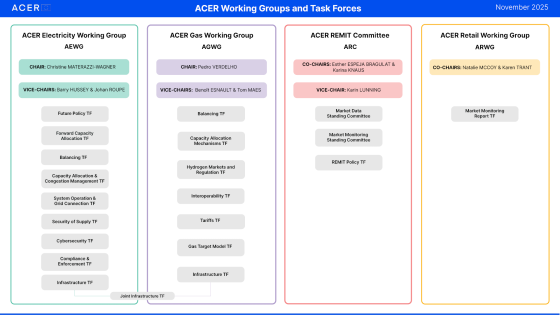↓ See also
Related documents
Related documents
Regulators propose changes for the TEN-E Regulation

The European Union Agency for the Cooperation of Energy Regulators (ACER) and the Council of European Energy Regulators (CEER) have published today a joint paper including recommendations ahead of the upcoming revision of the Guidelines for trans-European energy infrastructure Regulation (TEN-E Regulation).
The proposals focus on infrastructure development governance, scope and process. The European Commission intends to review and to revise the Regulation before the end of 2020 as one of the initiatives of the European Green Deal and it is currently consulting with stakeholders and regulators. This paper serves as a response to the public consultation as well.
Based on the extensive experience on the benefits and shortfalls of the current TEN-E Regulation, national regulatory authorities (NRAs) and ACER propose legislative changes to improve the planning and implementation of electricity and gas infrastructure, aiming to make it streamlined, focused on sustainability and neutral both in terms of technology and potential conflict of interest.
In the paper, ACER and CEER propose specific recommendations in the following three areas:
- governance of infrastructure development
- scope of principles for Projects of Common Interest
- TEN-E processes.
The European Commission is developing legislative proposals (as part of the Grids Package) to improve and simplify the current legal framework. This includes the revision and simplification of the 2022 Trans-European Energy Networks Regulation (TEN-E Regulation), a key framework for the European energy infrastructure development.
On 19 September 2025, ACER published a position paper on improving and simplifying the legal framework on European grids.
ACER Working Corner
ACER Working Corner
ACER Working Corner


ACER Working Corner
The ACER Boards
Board of Regulators
Next meeting | Previous meetings | Members page and Mailing lists | SoS and high energy prices: information exchange
Administrative Board
Next meeting | Previous meetings | Members page and Mailing lists
Board of Appeal
Next meeting | Previous meetings | Members page and Mailing lists
ACER Working Corner
Working Groups Committees
Electricity Working Group
Next meeting | Previous meetings | Members page and Mailing lists
Gas Working Group
Next meeting | Previous meetings | Members page and Mailing lists
ACER REMIT Committee
Next meeting | Previous meetings | Members page and Mailing lists
ACER Retail Market Working Group
Next meeting | Previous meetings | Members page and Mailing lists
ACER Working Corner
Task Forces, Standing Committees, Regional Initiatives and others
Task Forces – Under the Electricity Working Group
Balancing
Next meeting | Previous meetings | Members page and Mailing lists
Capacity Allocation and Congestion Management Task Force
Next meeting | Previous meetings | Members page and Mailing lists
Forward Capacity Allocation
Next meeting | Previous meetings | Members page and Mailing lists
Future Policy & Governance TF
Next meeting | Previous meetings | Members page and Mailing lists
Infrastructure
Next meeting | Previous meetings | Members page and Mailing lists
Security of Supply TF
Next meeting | Previous meetings | Members page and Mailing lists
System Operation and Grid Connection
Next meeting | Previous meetings | Members page and Mailing lists
Cybersecurity Task Force
Next meeting | Previous meetings | Members page and Mailing lists
Compliance and Enforcement
Next meeting | Previous meetings | Members page and Mailing lists
Task Forces – Under the Gas Working Group
Balancing
Next meeting | Previous meetings | Members page and Mailing lists
Capacity Allocation Mechanism
Next meeting | Previous meetings | Members page and Mailing lists
Infrastructure
Next meeting | Previous meetings | Members page and Mailing lists
Interoperability
Next meeting | Previous meetings | Members page and Mailing lists
Tariffs
Next meeting | Previous meetings | Members page and Mailing lists
Gas Target Model
Next meeting | Previous meetings | Members page and Mailing lists
Hydrogen Markets and Regulation
Next meeting | Previous meetings | Members page and Mailing lists
Task Forces and Standing Committees – Under the ACER REMIT Committee
(Archived) REMIT IT Management & Governance
Next meeting | Previous meetings | Members page and Mailing lists
REMIT Policy Task Force
Next meeting | Previous meetings | Members page and Mailing lists
Market Data Standing Committee
Next meeting | Previous meetings | Members page and Mailing lists
(Archived) Market Data Reporting Standing Committee
Next meeting | Previous meetings | Members page and Mailing lists
Market Monitoring Standing Committee
Next meeting | Previous meetings | Members page and Mailing lists
RISIG
Meetings workspace | Members page and Mailing lists
Task Forces – Under the Retail Working Group
Market Monitoring Task Force
Next meeting | Previous meetings | Members page and Mailing lists
Gas Regional Initiatives
Gas Regional Initiatives - Coordination Group
Next meeting | Previous meetings | Members page and Mailing list
Gas Regional Initiatives - South Region
Next meeting | Previous meetings
Gas Regional Initiatives - South south east Region
Next meeting | Previous meetings
Others task forces and groups
Joint Electricity and Gas Infrastructure Task Force
Next meeting | Previous meetings | Members page and Mailing lists
LEN (Legal Experts Network)
Next meeting | Previous meetings | Members page and Mailing lists
Communication Officer
Next meeting | Previous meetings | Members page and Mailing lists
NRA Press Network
Next meeting | Previous meetings | Members page and Mailing lists
Implementation
Implementation
RfG Implementation

As the Regulations do not foresee approvals by more than one regulatory authority, the Agency will not be asked to adopt decisions when regulatory authorities cannot agree on terms, conditions and methodologies.
RfG Implementation
The Agency monitors the procedure of granting derogations from one or more provisions of the RfG Regulation.
The relevant regulatory authority decides which power-generating modules should be classified as an emerging technology. Any regulatory authority of the relevant synchronous area may request a prior opinion from the Agency, which shall be issued within three months after receiving the request. The decision of the relevant regulatory authority shall then take into account the Agency's opinion.
All regulatory authorities of a synchronous area may also decide in a coordinated manner to withdraw a classification as an emerging technology. Also in this case, the regulatory authorities of the synchronous area concerned may request a prior opinion from the Agency, which shall be issued within three months. Where applicable, the coordinated decision of the regulatory authorities shall take into account ACER's opinion.
Find out more on how national regulatory authorities implemented the transitional arrangements for emerging technologies in the Implementation Monitoring Report of the Network Code on Requirements for Grid Connection of Generators.
The accumulated sales of power-generating modules classified as emerging technology are also made available by the national regulatory authorities every two months.
Implementation
DCC Implementation
The Agency monitors the procedure of granting derogations from one or more provisions of the DCC Regulation. The Agency may issue a reasoned recommendation to a regulatory authority to revoke a derogation, in case justification is missing.
Implementation
HVDC Implementation
The Agency monitors the procedure of granting derogations from one or more provisions of the HVDC Regulation. The Agency may issue a reasoned recommendation to a regulatory authority to revoke a derogation, in case justification is missing.
↓ See also
Exemptions
Exemptions
Ensuring non-discriminatory access to infrastructure
Transmission System Operators have to provide non-discriminatory access to their infrastructure and offer the same service and contractual conditions to other market players (third party access).
Regulatory authorities may grant exemptions for new interconnections in strict circumstances:
-
the investment must enhance competition in the electricity supply
-
the level of risk attached to the investment is such, that the investment would not take place without the exemption
-
the interconnection must be owned by a legally separate firm from the TSO in whose system it will be built;
-
the users of the interconnector must pay for it
-
the costs of the interconnection cannot be financed through charges for using the linked transmission or distribution systems
-
the exemption does not harm the competition or the efficient functioning of the market or the regulated system.
Exemptions
What's the role of ACER?
Regulatory authorities receiving a request for exemption should decide within six months. When NRAs fail to agree, or upon their joint request, ACER becomes responsible for adopting such decision.

Exemptions
The exemption process
A copy of every exemption request needs to be transmitted to the European Commission and to ACER on receipt.
Within two months, ACER can provide an opinion to the regulatory authorities involved.
If a decision is taken, this must be notified by the NRAs to the European Commission, together with all relevant information.
The decision shall be notified, without delay by the concerned regulatory authorities (or by ACER where the decision is taken by ACER), to the Commission, together with all the relevant information with respect to the decision.
The Commission may request to amend or withdraw the decision to grant an exemption. The exemption expires if the construction of the interconnector has not started within two years yet or the interconnector has not become operational within five years. The exemption may be extended if the delay is due to major obstacles beyond the control of the project promoter.
Documents
Research & Development
Research & Development
An holistic approach to innovation

Research, development and innovation could not be effective without the involvement of distribution and transmission system operators. To ensure an effective and inclusive energy transition, every stakeholder must play a role.
Cross border cooperation and knowledge sharing facilitate the efficient functioning of both the interconnected system and the internal energy market, making the cooperation of sector associations at European level a welcome approach.
Research & Development
What does ACER say?
Research, development and innovation activities, if conducted by regulated entities, require a clear assessment of their foreseen costs and benefits. ACER acknowledges that a CBA is difficult to conduct for such activities, but this fact should not defer regulated entities to establish project benefits in order to prove its benefit to the consumer. In this respect, the same level of transparency is required of such projects as of any other infrastructure project.
Congestion Revenues
Congestion Revenues
What is it?

Congestion management procedures associated with a pre-specified timeframe may generate revenue in case network congestion happens in that specific period.
However, all income generated as a result of the cross-zonal capacity allocation must be used as a priority for either guaranteeing the actual availability of the allocated capacity, or for maintaining or increasing cross-zonal capacities. Only where these objectives are fulfilled, the revenues can be used as income when determining network tariffs. Potential residual revenues shall be place on an internal account line until they can be spent for the abovementioned purposes.
The relevant methodology for congestion revenues use must be proposed by the TSOs and it has to set out:
-
the conditions under which congestion revenues can be used for fulfilling the priority objectives,
-
the conditions for placing the residual revenues on a separate internal account line for future use along with the amount of time those revenues can be placed on such an account line.
Transmission System Operators must report to national regulatory authorities (NRAs) how they are expecting to use the congestion income and how they actually used it. On yearly basis, NRAs must inform ACER and publish a report detailing the amount of the collected revenue, as well as how it was used in view of fulfilling the priority objectives. The report must also highlight the amount placed on a separate account line and the quantity used when calculating network tariffs.
Congestion Revenues
What's the role of ACER?
ACER decides on the proposed methodology and can request TSOs to amend or update it. ACER also receives yearly reports on the congestion revenue use from NRAs.
Inter-TSO Compensation monitoring
Inter-TSO Compensation monitoring
What is it?

The Inter-TSO Compensation (ITC) mechanism allows transmission system operators (TSOs) to receive a compensation for the costs of hosting cross-border flows on their networks. This compensation shall be paid by the operators of national transmission systems from which cross-border flows originate and the systems where those flows end.
Pursuant to Commission Regulation (EU) 838/2010, two types of costs shall be compensated:
- the costs of losses due to hosting cross-border flows of electricity and
- the costs of making infrastructure available to host these cross-border flows.
Inter-TSO Compensation monitoring
What's the role of ACER?
ACER monitors the implementation of the ITC mechanism as well as the management of the ITC fund and reports to the European Commission. ACER is also responsible for assessing the annual cross-border infrastructure compensation fund along with a recommendation and for providing an opinion on suitability of the methodology of using long run average incremental costs.
Inter-TSO Compensation monitoring
What does ACER say?
ACER recommends to limit the infrastructure compensation to existing infrastructures and to phase-out the infrastructure fund. In ACER's view, NRAs should also engage in cross-border cost allocation agreements for new investments and on implementing an ex-post compensation mechanism for the loop flow induced costs and losses due to cross-border flows. In 2022, during its annual monitoring on the ITC mechanism, ACER identified potential shortcomings and soon issued new recommendations to ENTSO-E, TSOs and NRAs on how to improve the treatment of electricity losses for the purpose of the ITC mechanism. In addition, ACER concluded in its Opinion that in the context of the current ITC mechanism, LRAIC methodology is of only limited suitability.
Reports
-
 Published on 12 March 2025
Published on 12 March 2025 Published on 26 July 2024
Published on 26 July 2024 Published on 14 December 2022
Published on 14 December 2022 Published on 15 November 2021
Published on 15 November 2021 Published on 1 December 2020
Published on 1 December 2020 Published on 16 December 2019
Published on 16 December 2019 Published on 31 October 2018
Published on 31 October 2018 Published on 21 December 2017
Published on 21 December 2017 Published on 15 November 2016
Published on 15 November 2016 Published on 5 November 2015
Published on 5 November 2015 Published on 14 November 2014
Published on 14 November 2014 Published on 9 October 2013
Published on 9 October 2013 Published on 11 September 2012
Published on 11 September 2012↓ See also
